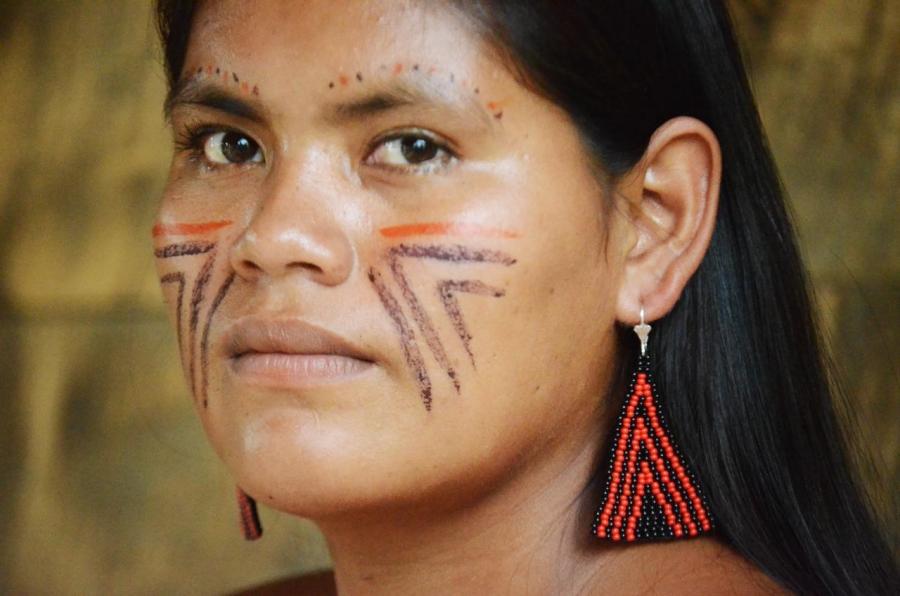Chinchero, a community of about 20,000 Quechua speakers, is situated on a plain at 3800 m. in the Peruvian Andes near Cuzco. The primary economic activity in Chinchero is potato agriculture, but in recent years tourism has increased drastically. The proposed location of the Cuzco International Airport in Chinchero threatens to both destroy fields and expand the number of visitors.
Tourists are attracted by Chinchero's spectacular setting, Inca ruins, people, and Sunday barter market. In spite of these outside influences Andean people are far more resilient in the face of cultural challenges than one might imagine.
Tourists are only the most recent agents of change in Chinchero. They were preceded by the Spanish and the Incas. Chinchero residents have always been regarded as independent, even contrary, by their neighbors. Their strong sense of cultural identity has kept them dressed and weaving differently from their neighbors. Women wove cloth for their own families, in the recognized style of the community. A few older women with extra time contracted weaving for other families, usually with materials brought to them.
Although such exchanges still take place, the arrival of thousands of tourists to the Cuzco area every year has created a new market for woven goods. Weavers do not market their own products; instead, middlemen travel to the outlying areas of Cuzco trading alcohol, rice, sugar, and some money for textiles, which they in turn sell in the markets and stores of Cuzco, Lima, and the U.S. for tremendous profits.
Alert Chinchero businesswomen recognized the potential in this market, and began marketing directly to tourists in the plazas of Chinchero and Cuzco. The weaver can depend on selling many small items every week (e.g. belts); but cannot count on selling even one larger project. Further, the tourist is ignorant of the weaver's craft and cannot tell the difference between easy and complicated patterns and techniques, synthetic or handspun yarns, etc.
Chinchero women now weave "ley" (supplementary-warp) belts in gaudy colors of Dralon yarn. Three can be woven per day and sold for $2 each. Young girls are now learning to weave only these "ley" belts, rather than traditional larger cloths and more complicated patterns.
The artistic deterioration of Chinchero weaving will be halted only when the weavers once again value their own tradition and when consumers learn to recognize and value fine weaving. Education has appeared to be the best solution. Towards this goal, the Chinchero Center for Traditional Culture was established.
The idea for the Center arose from town discussions. In 1977, the American Museum of Natural History commissioned a series of textiles. We explained to the weavers the destination of their work. One villager asked, "So you mean all those textiles that foreigners have bought from me over the years, are all in museums?" Further explanation of what a museum was led to the obvious question, "Could we have a museum?" To which we answered yes, of course. The town provided a building; Cultural Survival, Earthwatch, and other donors provided funds and time.
In May, 1980 the Center opened its doors, housing exhibits of traditional agriculture, ritual and household life, and art based on photographs, tape recordings and artifacts. The Center is accessible to tourists but was designed for the residents of Chinchero.
The Center also includes an archive of photographs, tape recordings, and other kinds of information which we hope will make it possible for young people to learn about traditional Chinchero, even after the old people are gone. The museum utilizes media impressiveness to lend prestige to traditional life. Although Chincherinos are among the most-photographed people in the Andes, having even served as a set for a Hollywood movie (The Last Movie), few photographs found their way back to Chinchero. In the same way, little had remained there from the countless anthropologists who have worked there over the past forty years. Finally, we wanted to bring to Chinchero some of the results of our work.
Isolating Chincherinos from the intrusion of modern goods, people, and ideas is not only impossible, but not necessarily desirable. Chinchero people want to pick and choose among traditional and modern lifestyles to find one that is truly their own.
As people acquire needs for money, marketing of crafts may be the only way these arts can survive. Certainly a weaver can earn as much as a waitress or a maid, other avenues of employment open to Chinchero women. The present marketing structure, however, gives advantage to the middleman and undermines the quality of production. The Chinchero Center will help weavers in Chinchero to know the value of their own work, and to hold out against middlemen who tell them it is worth little. It will also encourage young people to learn to weave. In the future a cooperative alternative marketing structure for traditional crafts in the Cuzco area might benefit local weavers. A number of people have suggested annual textile fairs, where recognition and prizes would be given for fine weaving.
North Americans have much to learn about the real nature of traditional Andean weaving. In 1981, through the auspices of Cultural Survival and the American Indian Community House in New York, Nilda Callanaupa, a fine weaver and Chinchero's first female university student, visited the United States, lecturing and demonstrating her craft as well as practicing some reverse tourism.
As of September, 1982, the Center is run entirely by the townspeople of Chinchero; the museum is open on a regular basis and beginning to support itself. This work is possible only through the contributions of individuals.
Article copyright Cultural Survival, Inc.



